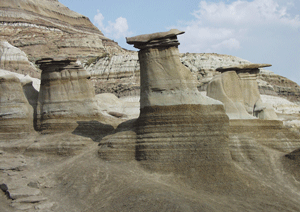
A man has been fined $1,000 for engraving his name in the hoodoos.
Jorge Edgardo Carrillo of Calgary appeared in provincial court in Drumheller on Friday, August 26. He pleaded guilty at his first court appearance to destroy or disturb a historical land site contrary to the Alberta Historical Resources Act.
The court heard that on April 20 of this year Carrillo was visiting the Hoodoos in Drumheller. He used a key to engrave his name, the name of his daughter, the date and the word Columbia into the second largest hoodoo at the site.
His activities were witnessed by a civilian who asked him to stop. He apologized and left the site.
The civilian attained his licence plate and contacted the RCMP. Carrillo was stopped by the police and admitted his involvement.
Lawyer John Getz, acting as duty council spoke for Carrillo. He said Carrillo had no intent to break the law. Carrillo came to Canada in 2005 and does not read English, therefore was not able to read the signage warning of fines ranging up to $50,000. The appearance of other graffiti on the site also made him infer it was acceptable. The 32 year old, through his lawyer wanted to make it clear that he had never had a run in with the law before, and that he was remorseful for his actions.
Judge Grieve went along with Crown Prosecutor’s recommendation of a $1,000 fine. He condemned the action, saying even a visitor who had never seen or read about the Hoodoos could see they were formed by millions of years of rain and wind action. Unlike graffiti on a bridge, this simply can’t be painted over.
“They can’t be fixed and you know that, and to do it in front of your child is shameful,” said Grieve. “Now when I go to visit, instead of seeing nature, I see ‘Jorge was Here.'”
Brian Ronaghan, director of the Archaeological Survey said it is not common for an offence of this nature to be pursued under the Historical Resources Act. Often the locations are remote, and it is hard to catch someone in the act. Typically, the act is geared for industry and making sure proper precautions are taken in development, and typically, industry is responsible.
He said most of what is protected under the act is man made, but there are a few natural historical resources that are protected.
“It is a rare occurrence and it is nice to have it (the Act) because it serves as a threat and it is useful to that extent,” he said. “If someone like this is charged under our act, maybe that stops someone else.”